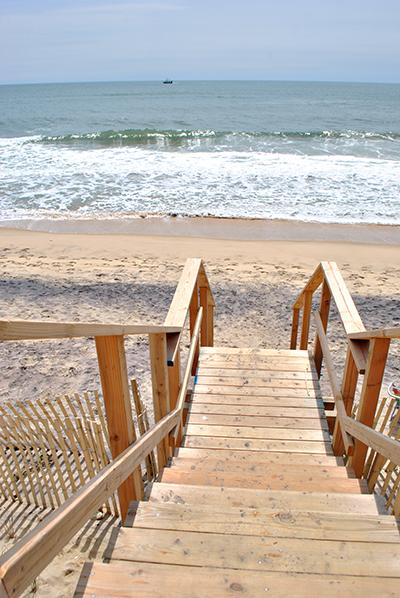Problems Dog Dunes

The Army Corps of Engineers considers its installation of an artificial dune along the downtown Montauk beach complete, but as Memorial Day approaches questions remain about access for beachgoers, including the handicapped. The dune, a 3,100-foot-long stretch of geotextile sandbags covered with three feet of sand, is intended to create a barrier to ocean waves that could threaten the downtown business district.
At the East Hampton Town Board meeting on May 10, Supervisor Larry Cantwell said that from the town’s perspective there are several outstanding issues, including the grade level access to the beach at South Edison Street, the wooden walkway over the dune at Lowenstein Court, and the plan for a handicapped access ramp near the Royal Atlantic motel. The chairwoman of the Montauk Citizens Advisory Committee went further, however.
“I’d like to address the abomination that is those stairs on the beach,” Diane Hausman, the chairwoman of the advisory committee, said.
Stairs, at four places over the dune, have replaced traditional sand paths to the beach, as the geotextile bags cannot be walked on. Several steps lead up to a platform and then there is a descent of even more steps down to the beach. The steps will not only be an impediment to people with physical handicaps, Ms. Hausman said, but will present problems for other beachgoers carrying children or gear.
“You can’t get two people abreast on those stairs,” said Ms. Hausman, an owner of the Sands Motel, just across from the beach. “How are they going to get their kids up and down those stairs, how are they going to get their coolers. . . . Never mind the handicapped people that can’t do stairs.”
At South Edison Street, interlocking concrete paving blocks laid at the road end and covered with sand were exposed during recent heavy rains. The water washed away the sand over the pavers, which have holes similar to those in cinder blocks. That can be expected to occur again, as runoff from the downtown area flows onto the beach there. The dead end was kept at grade so as not to impede that flow and cause flooding, and to provide an emergency vehicle access to the beach.
Several Montaukers have expressed concern about the safety of pedestrians who have to walk across the pavers, called articulating concrete blocks, to get onto the sand.
Mr. Cantwell said the Highway Department had recovered the pavers with sand after the rains, and he is negotiating with the Army Corps to make changes there. He told the Corps, he said, there is an “unsafe condition at present. They need to figure out a way to stabilize it. When that . . . is exposed, it’s a hazard.”
At Lowenstein Court changes need to be made to the walkway, where different levels make it hard to climb, Mr. Cantwell said. The town is sending the Corps a proposal to correct that, he said, “and then we’re going to argue over who’s going to build it, and who’s going to pay for it.” The Corps has agreed, he said, to move a drainage pipe that pumps water out right next to the footing of the stairs.
The Corps also has agreed, in concept, to a handicapped-accessible ramp at the beach access next to the Royal Atlantic, though it will be installed at town expense.
The ramp, Mr. Cantwell explained at the meeting, will allow those in wheelchairs to reach a platform at the top of the steps, but it cannot take people down to the sand itself. The beach is not wide enough to accommodate the ramp length that would be needed for a safe slope, he said.
Mr. Cantwell noted that providing handicapped access to beaches according to the standards of the Americans With Disabilities Act has always been a challenge. “The town’s position has always been that the town would make available a sand wheelchair,” he said.
The vehicle access point at South Edison remains a possible ingress for wheelchairs, he said, though it is unclear what the surface there would be if the pavers were removed. Large railbed-type gravel has been put down at other beach access points.
“The pavers are going to be covered one way or the other,” Mr. Cantwell said. “I don’t know what the ultimate solution will be there.”
In an interview following the meeting, Ms. Hausman said though the motel’s business is just warming up for the season, “90 percent of the guests that I’ve had here already — they look, and go, ‘What the hell is that over there?’ ”
A member of one family, which brings 40 to 50 people to her motel for reunions, visited recently, and, noting the stairs, told Ms. Hausman that the difficulty the stairs would cause in accessing the beach would keep one family member of limited mobility from coming to Montauk this year.
“Now we’re cutting into my business,” Ms. Hausman said. “There’s going to be people who can’t get to the beach.”
